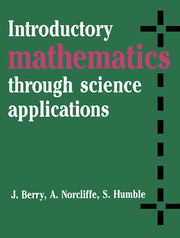Book contents
- Frontmatter
- Contents
- Preface
- 1 Basic functions
- 2 Functions for science 1: the exponential function
- 3 Functions for science 2: trigonometric functions
- 4 Functions for science 3: inverse functions
- 5 Other functions of science
- 6 Differentiation 1: rates of change
- 7 Differentiation 2: stationary points
- 8 Differentiation 3: approximation of functions
- 9 Integration 1: introduction and standard forms
- 10 Integration 2: techniques of integration
- 11 Integration 3: further techniques
- 12 First-order ordinary differential equations
- 13 Second-order ordinary differential equations
- 14 Statistics 1: frequency distributions and associated measures
- 15 Statistics 2: probability and probability distributions
- 16 Statistics 3: sampling, sampling distributions and hypothesis testing
- 17 Partial differentiation 1: introduction
- 18 Partial differentiation 2: stationary points
- Answers to the exercises
- Index
4 - Functions for science 3: inverse functions
Published online by Cambridge University Press: 05 June 2012
- Frontmatter
- Contents
- Preface
- 1 Basic functions
- 2 Functions for science 1: the exponential function
- 3 Functions for science 2: trigonometric functions
- 4 Functions for science 3: inverse functions
- 5 Other functions of science
- 6 Differentiation 1: rates of change
- 7 Differentiation 2: stationary points
- 8 Differentiation 3: approximation of functions
- 9 Integration 1: introduction and standard forms
- 10 Integration 2: techniques of integration
- 11 Integration 3: further techniques
- 12 First-order ordinary differential equations
- 13 Second-order ordinary differential equations
- 14 Statistics 1: frequency distributions and associated measures
- 15 Statistics 2: probability and probability distributions
- 16 Statistics 3: sampling, sampling distributions and hypothesis testing
- 17 Partial differentiation 1: introduction
- 18 Partial differentiation 2: stationary points
- Answers to the exercises
- Index
Summary
Scientific context
In the first three chapters, by looking at appropriate examples from science, we have been able to motivate the study of polynomials, exponential functions and trigonometric functions. For example, by looking at the growth of a certain kind of bacterium and asking how large the colony would be after time t, we arrived quite naturally at the exponential function. However, had we looked at this growth problem from a different standpoint and tried to discover how long it would be before the colony reached a certain size, we would have been led to a quite different but not unrelated function. In our study of the growth process the independent variable was the time t and the dependent variable was the number N of the bacterium. Had we adopted this different standpoint, the role of the variables would have been reversed. N would now be the independent variable and t the dependent one. The function we would have been led to would have been the so-called inverse function of the exponential function. Many functions have inverses and these inverse functions often play an important role in mathematical modelling. In this chapter we look at those inverse functions that are of importance in science.
Example 1: bacterial growth revisited. The models of growth and decay that we have produced so far have all been geared to telling us how large something might be after a certain period, or what the temperature of a cooling body is after a certain time interval, and so on.
- Type
- Chapter
- Information
- Introductory Mathematics through Science Applications , pp. 101 - 131Publisher: Cambridge University PressPrint publication year: 1989



